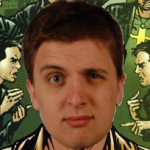
Wow. Hello. Welcome to a new feature. It's a thing.
... Uh... A thing... About comics?
No? Yes, vague I know.
... Urm... OH! Yeah, this one's about Sub Mariner: The Depths.
Which... Isn't about the Sub Mariner, REALLY.
Still, in this new feature I'll be explaining the comic, why it's great and so on.
Mainly though, I'll be confused. Well that or focus mainly on what it is and how it isn't what you'd think.
Confused? Yeah I know.
HIT THE JUMP TO KNOW WHY SUB MARINER: THE DEPTHS ISN'T WHAT YOU'D THINK!
Now that I've gotten the confusion all out of me I can get to the point. This is NOT a comic you would buy because you're a fan of Namor. Mainly because NO-ONE is a fan of the Sub Mariner. I mean why would you be? He hasn't had a good series in... Well I've never read a good series featuring him. Sure people'll bring up how good he is in Civil War or Stan Lee's Fantastic Four stuff, but can you HONESTLY say you've enjoyed, let alone read any series where he's the star?
...
No. No you haven't. Mainly because there aren't any readers here. Still who can blame you? A really crappy series spinning out of Civil War? EH. Weak 12 issue series in 2003? PAH!.... Uh... I think that's it unless you jump back to the late 90s.
Character's shit. One tone. Bland. Royal blah blah blah. Dark Reign stuff... Etcetera. So how do you make such a character awesome?

POINTED. FUCKING. TEETH.
Seriously make him look this sinister in all the sub mariner comics and I'd love them regardless of how awful they are. But as I've said this book isn't what you think. How? Well, Namor's barely in it for starters.
"WAIT, WHAT?!" I hear... I don't know... Three of you say? Yeah that's a good number. Yeah, so I hear you three say wait what and I say "I KNOW!". But trust me, that's exactly why this is a great Sub Mariner comic. It isn't about Namor. Except it is. It's about the conceptual entity that is Namor for the most part, and one man's attempts to remain sceptical in the face of horror and his own mind. In fact yeah let's talk about that guy.
 This is Dr. Stein, professional sceptic (debunker?) and best villain-looking moustache of the piece. More on facial hair later maybe. Dr. Stein is a ridiculously deep look at the non-believer, someone who rejects everything and despite what even he himself sees will fight to the end that it is untrue. Throughout the course of this comic we see him lead a submarine voyage to prove Atlantis and Namor don't exist. OH and make sure some people aren't dead in the process. On this fantastic voyage he is generally a huge douchebag and steadily goes insane, seeing things that go against his beliefs like, say, a pointy toothed fish-man or just general spooky shit. As far as seeing a character develop over a storyline this man is up there with... I don't know. A really well developed character. I'm not sure who I coulda said there.
This is Dr. Stein, professional sceptic (debunker?) and best villain-looking moustache of the piece. More on facial hair later maybe. Dr. Stein is a ridiculously deep look at the non-believer, someone who rejects everything and despite what even he himself sees will fight to the end that it is untrue. Throughout the course of this comic we see him lead a submarine voyage to prove Atlantis and Namor don't exist. OH and make sure some people aren't dead in the process. On this fantastic voyage he is generally a huge douchebag and steadily goes insane, seeing things that go against his beliefs like, say, a pointy toothed fish-man or just general spooky shit. As far as seeing a character develop over a storyline this man is up there with... I don't know. A really well developed character. I'm not sure who I coulda said there.Perhaps that's the biggest thing that makes this completely different to anything you'd expect. Character's all at least APPEAR to have depth. Some will only get seconds of air-time and you'll still get the gist of their character. When you open a comic expecting it to be about Namor and his faceless Atlantean soldiers you can never expect to get a great character driven analysis of madness and the nature of human beings. In fact you don't expect that from pretty much any Marvel comic nowadays.
To wrap up I really have to highlight the ending. Without spoiling too much it has a sense of tragedy like no other and reminds you that humans are ultimately pathetic beings as prone to being killed, lying, deceiving and going to extremes for their beliefs, even in the face of ultimate proof. I can't see there being an ending this interesting in another Marvel comic. Yeah, you could even say that it has DEPTH AHAHAHAHAHAHAAHAHA *slap* ow!
So yeah, a brilliant Sub Mariner comic. And some writing where I haven't had to talk about flippin' moments, the writer OR the artist (though I must quickly mention that I haven't liked Ribic's art outside of this). A good day.
And now you know why Sub Mariner: The Depths isn't what you'd expect.
Next time?: more images to make the text more bearable
Read More ..




















































